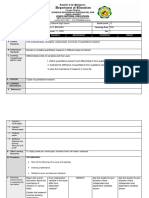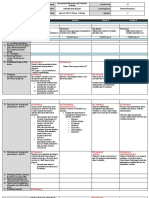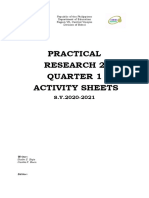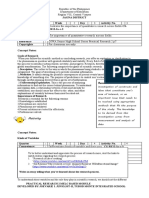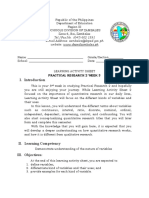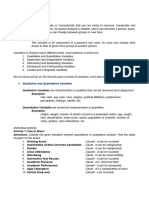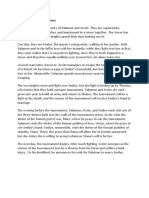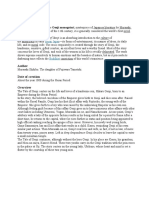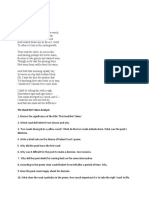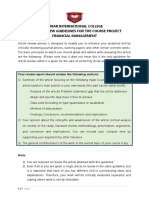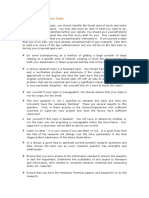School: ENRILE VOCATIONAL HIGH SCHOOL Grade Level: GRADE 12-HUMSS, STEM
DAILY LESSON LOG Teacher: MEDIATRIX V. TRINIDAD Learning Area: PRACTICAL RESEARCH 2
Teaching Dates & Time: JUNE 30-July 4, 2025 Quarter: Quarter 1
MONDAY TUESDAY WEDNESDAY THURSDAY
OBJECTIVES
A. Content Standards The learners demonstrate understanding of...
1. the characteristics, strengths, weaknesses, and kinds of quantitative research
2. the importance of quantitative research across fields
3. the nature of variable
B. Performance Standards The learners should be able to decide on suitable quantitative research in different areas of interest
C. Learning Competencies/ Differentiate kinds of variables and their uses (CS_RS12-Ia-c-3)
Objectives Specific Objectives:
a. differentiate qualitative and quantitative variables.
b. distinguish variables from sample quantitative researches.
c. differentiate dependent and independent variables.
d. classify variables according to its types.
e. examine sample quantitative researches depicting dependent and independent variables
I. CONTENT QUALITATIVE AND QUANTITATIVE VARIABLES/ INDEPENDENT AND DEPENDENT VARIABLE
II. LEARNING
RESOURCES Power point presentation
A. References https://www.youtube.com/watch?v=r0BTlu8bFcY&list=PLVcgq55GYbspGzx5yWLxy8HB6DiYlxzAZ&index=3
1. Teacher’s Guide pages
2. Learner’s Material
pages
3. Textbook pages
4. Additional Materials
from Learning Resource
LR portal
B. Other Learning
Resources
III. PROCEDURE
A. Reviewing previous Begin the lesson by briefly Begin the lesson by reviewing Greet the students and briefly Recall the previous lessons
reviewing the concept of the concept of variables recap the key points from the that were discussed
� Lesson or presenting new variables from the previous and their role in research. previous lesson on the basics throughout the week.
lesson lesson. of quantitative research.
Briefly discuss the difference
Introduce the new lesson by between qualitative and Introduce the new lesson by
asking students if they quantitative variables. stating that today's focus will
remember the types of be on examining sample
variables they learned about Emphasize the importance of quantitative researches to
last time. variables in formulating identify and understand the
research questions and dependent and independent
hypotheses. variables.
B. Establishing a purpose for Explain that in this lesson, Explain that in this lesson, Explain the importance of Tell the students that they will
the lesson students will delve deeper into students will deepen their understanding dependent be having a quiz today to
the types of variables used understanding of variables by and independent variables in assess their learnings.
in research and learning to differentiate quantitative research.
learn how to differentiate between dependent
between qualitative and and independent variables, as Emphasize that these
quantitative variables. well as classify variables variables form the foundation
State that by the end of the according to their types. of any research study and are
lesson, students should be crucial for drawing meaningful
able to distinguish between conclusions.
these variables and
understand their significance
in quantitative
research.
C. Presenting examples/ Display examples of Present different research Display a sample quantitative Ask students to give examples
instances of the new qualitative and quantitative scenarios to the class, each research paper on the or instances of things or
lesson. variables using a multimedia with a clear dependent projector screen (or distribute ideas they have acquired from
presentation. variable and one or more printed copies). the different topics discussed
independent variables. throughout the week.
Qualitative variable example: Walk the students through the
Hair color (categories: black, For example: paper, pointing out and
brown, blonde, etc.) Research Scenario 1: explaining the dependent and
●Dependent Variable: independent variables in the
Test Scores study.
Quantitative variable ●Independent Variable: Briefly discuss how the
example: Study Time variables are related and why
Height (measured in inches they are important to the
� or centimeters) Research Scenario 2: study's research questions.
●Dependent Variable: Heart
Rate
Independent Variable:
Exercise Intensity
Discuss each scenario,
highlighting the roles of
dependent and independent
variables
D. Discussing new concepts Define qualitative and Explain the concepts of Break the students into small Give enough time to students
and practicing new skills. quantitative variables with dependent and independent groups and provide each to review their notes.
#1 clear explanations and visual variables in depth: group with a different sample
aids. quantitative research paper.
●Dependent Variable: The
Qualitative variables: outcome being measured or Instruct the groups to identify
Characteristics or qualities observed; it responds to and list the dependent and
that can be observed and changes in the independent independent variables in their
categorized (e.g. gender, variable. assigned paper.
color, nationality). ●Independent Variable: After 5 minutes, have each
The variable that is group present their findings
Quantitative variables: manipulated or controlled by to the class, explaining their
Numerical the researcher; it is believed to reasoning.
measurements or quantities influence the dependent
(e.g. age, weight, income). variable.
Engage students in a Provide additional examples
class discussion by asking and ask students to identify
them to provide more the
examples of each type of dependent and independent
variable. variables in each scenario
E. Discussing new concepts Introduce the concept of Introduce the different Distribute the practice questions handout to each student.
and practicing new skills sample quantitative types of variables: nominal, Individually, students should read the provided research
#2. researches. ordinal, interval, and ratio. scenarios and identify the dependent and independent
Explain that sample Explain the variables in each scenario.
quantitative characteristics of each type:
researches involve collecting ●Nominal: Categories with Walk around the classroom to provide assistance and answer
data on a subset (sample) of no inherent order (e.g., questions.
a larger population to make gender, eye color After completing the handout, discuss the correct answers as a
� inferences about the class, addressing any misconceptions.
population as a whole. ●Ordinal: Categories with a
meaningful order (e.g.,
Show examples of sample education level, income
quantitative research groups)
studies (handouts or ●Interval: Equal intervals
projected on the between values, but no
board). true zero point (e.g.,
temperature in Celsius)
Break students into pairs or ●Ratio: Equal intervals with a
small groups and provide true zero point (e.g.,
them with a sample height, weight)
quantitative research
study. Present examples of variables
for each type and ask
Ask them to identify and list students to classify them
the variables present in the accordingly.
study.
F. Developing Mastery Divide the class into groups Engaging Activity: Assign each student a different
(Lead to Formative and provide each group with a Variable sample quantitative research paper
Assessment 3) set of index cards. Classification Relay (different from the ones used before).
On each index card, write ●Divide the class into groups.
down a variable (both ●Provide each group with index Instruct students to thoroughly read
qualitative and cards labeled with different their assigned paper and create a
quantitative) along with a variable types. brief presentation that highlights the
brief description of a research ●Display a list of variables dependent and independent
scenario. (e.g., age, favorite color, variables, their relationship and the
income, temperature) on the significance of the variables to the
Have each group sort board. study.
the index cards into two ●Each group must categorize Each student will present their
categories: the variables by placing the analysis to the class. Encourage
qualitative and quantitative corresponding index card next questions and discussions after each
variables. to each variable. presentation.
After sorting, ask each group ●The group that correctly
to present their classifies the most
categorizations to the class variables within the given time
and explain their reasoning. wins.
G. Finding practical Engage in a brief discussion Discuss how understanding Lead a class discussion
application of concepts about how understanding dependent and independent about how understanding
� and skills in daily living qualitative and quantitative variables, as well as variable dependent and independent
variables can be useful in types, is relevant in everyday variables can be useful
everyday situations. life. in everyday life, beyond
research settings.
Examples: Making decisions Examples could include
based on survey results, analyzing shopping habits, Give examples related to
analyzing market research health behaviors, or social making informed decisions,
data, interpreting health media usage. understanding cause-and-
statistics. effect relationships, and
evaluating information.
H. Making Generalizations Lead a class discussion Lead a class discussion on the Summarize the main concepts covered in the lesson and
and Abstraction about the to summarize key importance of variables in encourage students to reflect on their learning. Ask questions
Lesson. takeaways from research and the significance like:
the lesson. of classifying variables
Emphasize the importance correctly for accurate analysis 1. "Why is it important to differentiate between dependent and
of distinguishing between and interpretation. independent variables?"
qualitative and quantitative
variables in research. 2. "How might understanding these concepts impact your
Encourage students to approach to evaluating research studies?"
think critically about how
these concepts apply to
real-world situations
I. Evaluating Learning Distribute a short quiz or Administer a short quiz with For students who finish the Administer the quiz to the
assessment to gauge multiple-choice questions and quiz early, provide an class to assess their
students' understanding of scenario-based questions to additional worksheet with learning. Make sure
the concepts learned in the assess students' understanding more research scenarios for that the test covers all the
lesson. of the concepts covered in the them to practice identifying topics that were discussed
The quiz could include lesson dependent and independent throughout the week.
variables.
identifying variables, After checking the paper, give
differentiating between feedback to the students so
For students who may need
qualitative and quantitative remediation, offer one-on-one that they will know better the
variables, and analyzing a or small-group sessions to topics.
sample quantitative research review the concepts and
study. provide extra practice.
J. Additional Activities for For students who finish the Application: Students can
Application or quiz early or need further design their own research
Remediation reinforcement, provide scenarios with clear
� additional. dependent and independent
variables, and present them to
Application: Students can the class for analysis.
design their own research
scenarios with clear Remediation:
dependent and research Provide additional research
scenarios for them to practice scenarios for students to
identifying variables. practice identifying dependent
Assign homework that and independent variables
involves reading a simple and classifying variable types
research article and
identifying variables within it.
IV. REMARKS
V. REFLECTION
A. No. of learners earned
80%in the evaluation.
B. No. of learners who
required additional activities
for remediation who scored
below 80%
C. Did the remedial lesson
work? No. of learners who
have caught up with the
lesson.
D. No. of learner who
continue to require
remediation
E. Which of my teaching
strategies worked well?
Why did these work?
F. What difficulties did I
encounter which my
principal or supervisor can
help me solve?
G. What innovation or
localized materials did I
used/discover which I wish
to share with other
teachers?
� Prepared by: Checked by: Noted:
MEDIATRIX V. TRINIDAD LANY N. RANCES GAYLE ZANNETT D. LUYUN, PhD
Teacher II Head Teacher III PRINCIPAL III




